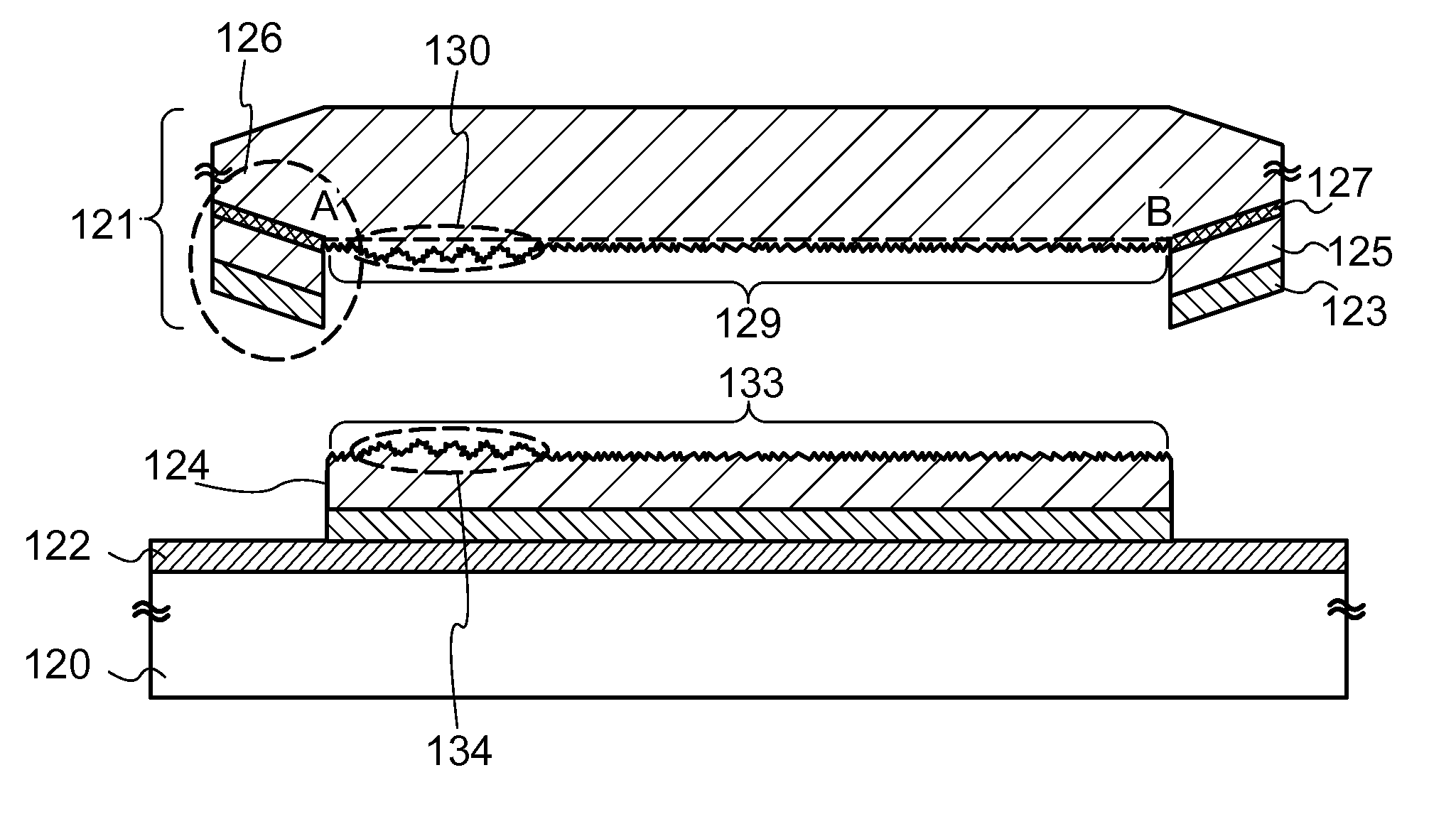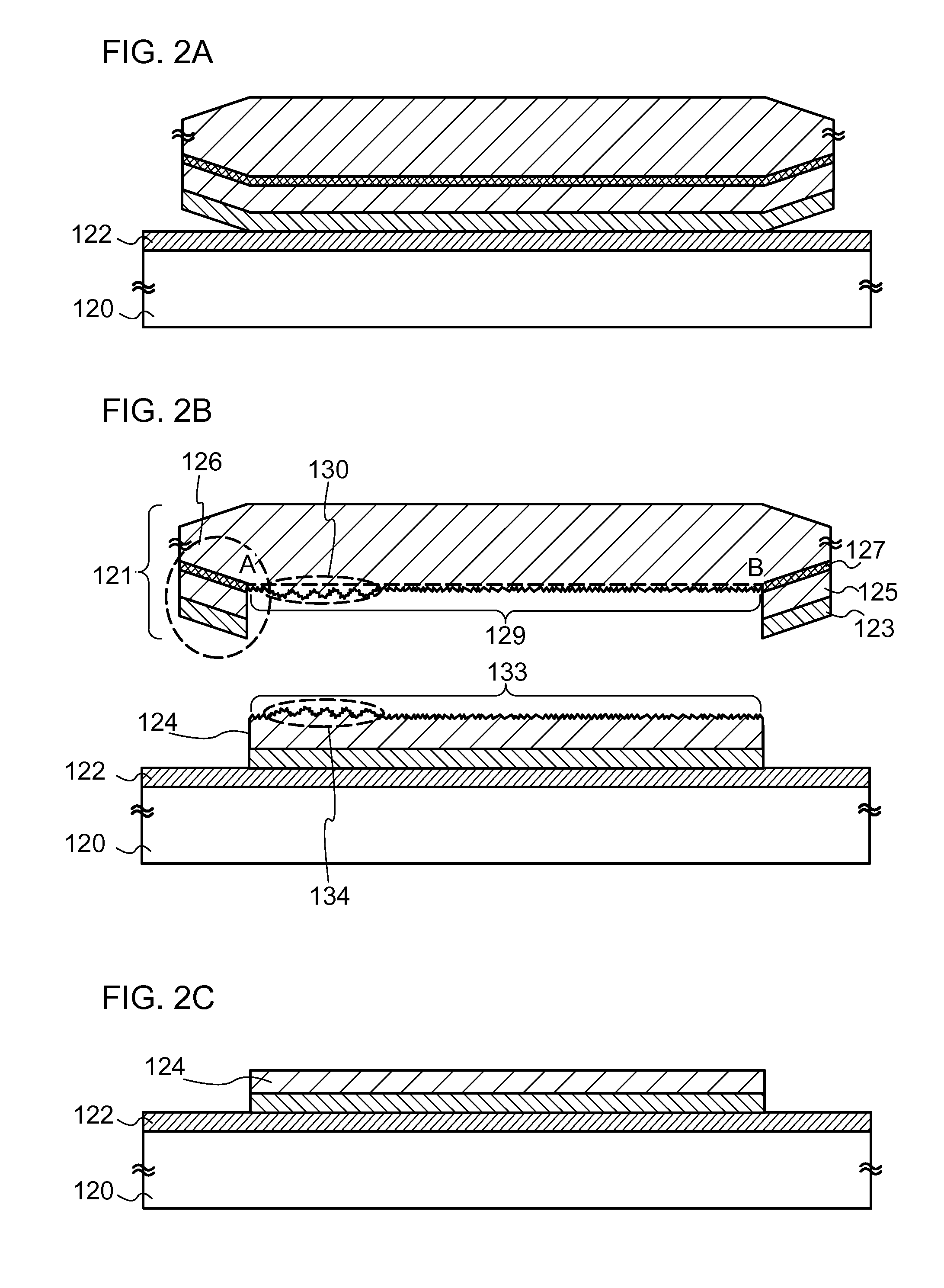Method for manufacturing soi substrate
a technology of silicononinsulator and substrate, which is applied in the direction of semiconductor/solid-state device manufacturing, basic electric elements, electric apparatus, etc., can solve the problems of damage to the planarity of the separated bond substrate, inability to sufficiently bond glass substrate and a bond substrate to each other, and inability to achieve uniform thickness. uniformity,
- Summary
- Abstract
- Description
- Claims
- Application Information
AI Technical Summary
Problems solved by technology
Method used
Image
Examples
embodiment 1
[0040]In a method for manufacturing an SOI substrate according to this embodiment, an SOI substrate is manufactured in such a manner that a semiconductor film separated from a semiconductor substrate which is a bond substrate is bonded to a base substrate. The separated bond substrate from which the semiconductor film has been separated is subjected to reprocessing treatment and reused as a bond substrate. Hereinafter, with reference to FIGS. 1A to 1C, FIGS. 2A to 2C, FIGS. 3A to 3C, FIGS. 4A to 4C, FIG. 5, and FIG. 6 which illustrate steps of manufacturing an SOI substrate, one of methods for manufacturing an SOI substrate of this embodiment will be described.
[0041]First, a process of forming an embrittlement layer 104 in a bond substrate 100 and preparing for bonding the bond substrate 100 to a glass substrate 120 which is a base substrate will be described. The following process corresponds to Process A (bond substrate process) in FIG. 6.
[0042]First, the bond substrate 100 as ill...
embodiment 2
[0120]In this embodiment, a method for manufacturing a semiconductor device by using the SOI substrate manufactured according to the above embodiment will be described. Note that a process described in this embodiment corresponds to a process F (a device process) in FIG. 6.
[0121]First, with reference to FIGS. 7A to 7D and FIGS. 8A to 8C, a method for manufacturing an n-channel thin film transistor and a p-channel thin film transistor will be described. Various kinds of semiconductor devices can be formed by combining a plurality of thin film transistors (TFTs).
[0122]The case where the SOI substrate manufactured by the method of Embodiment 1 is used as an SOI substrate will be described. FIG. 7A is a cross-sectional view of the SOI substrate in FIG. 2C.
[0123]The semiconductor film 124 is separated into each element by etching to form a semiconductor film 251 and a semiconductor film 252 as illustrated in FIG. 7B. The semiconductor film 251 is included in an n-channel TFT, and the sem...
embodiment 3
[0135]In this embodiment, specific modes of a semiconductor device manufactured by using an SOI substrate described in the above embodiment will be described with reference to FIG. 9 and FIG. 10.
[0136]First, a microprocessor will be described as an example of a semiconductor device. FIG. 9 is a block diagram illustrating a structural example of a microprocessor 500.
[0137]The microprocessor 500 has an arithmetic logic unit (also referred to as an ALU) 501, an ALU controller 502, an instruction decoder 503, an interrupt controller 504, a timing controller 505, a register 506, a register controller 507, a bus interface (Bus I / F) 508, a read only memory (ROM) 509, and a ROM interface 510.
[0138]An instruction input to the microprocessor 500 via the bus interface 508 is input to the instruction decoder 503 and decoded. Then, the instruction is input to the ALU controller 502, the interrupt controller 504, the register controller 507, and the timing controller 505. The ALU controller 502, ...
PUM
| Property | Measurement | Unit |
|---|---|---|
| thickness | aaaaa | aaaaa |
| diameter | aaaaa | aaaaa |
| diameter | aaaaa | aaaaa |
Abstract
Description
Claims
Application Information
 Login to View More
Login to View More - R&D
- Intellectual Property
- Life Sciences
- Materials
- Tech Scout
- Unparalleled Data Quality
- Higher Quality Content
- 60% Fewer Hallucinations
Browse by: Latest US Patents, China's latest patents, Technical Efficacy Thesaurus, Application Domain, Technology Topic, Popular Technical Reports.
© 2025 PatSnap. All rights reserved.Legal|Privacy policy|Modern Slavery Act Transparency Statement|Sitemap|About US| Contact US: help@patsnap.com



